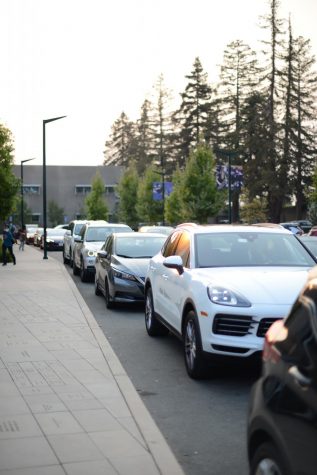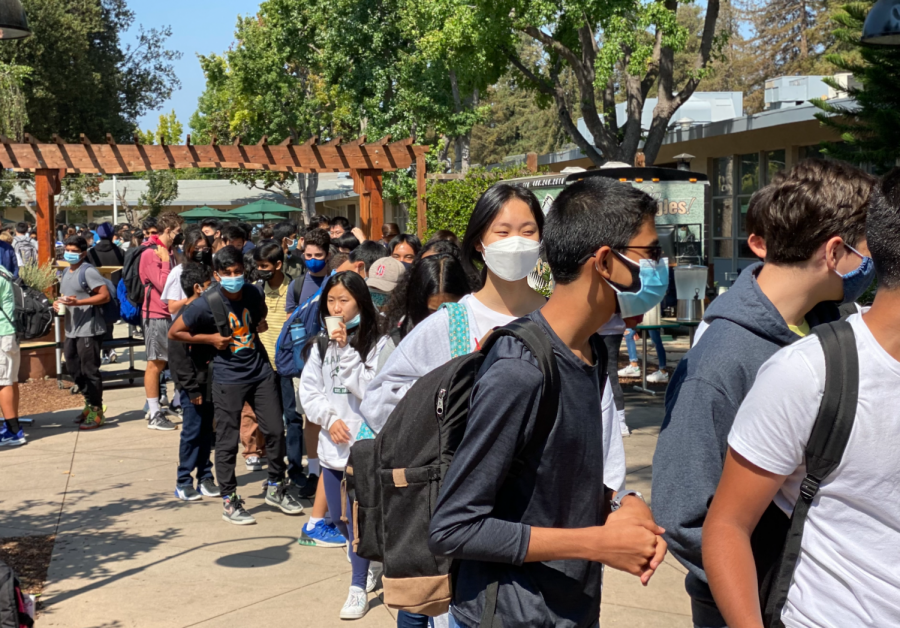Campus crowding: Did longer lines lead to seating shortage?
Students stand in the lunch line trailing into the quad on Aug. 23. Due to Harker’s COVID-19 practices in trying to limit student numbers indoors, faculty have been trying to keep the line inside as short as possible, leading to longer lines outside.
During the first weeks of school, students have crowded in lunch lines stretching from Manzanita all the way to the Quad, and the traffic has been worse, with students showing up late to class. The crowding around campus, including longer lunch lines, more time-consuming morning traffic and the lack of sufficient lunch tables have affected students as administrators and student representatives search for solutions.
The lunch lines look longer this year compared to past years because of Harker’s COVID-19 practices that try to keep as few students gathered indoors as possible. According to Community service director and Activities coordinator Kerry Enzensperger, who often monitors the lunch line entering Manzanita, the faculty have been trying to keep the line inside as short as possible, meaning the line ends up curling outside.
“The kitchen likes it when there are not too many people in there, because if we allow 100 plus people to walk in at one time, you’re still standing in another line,” Enzensperger said. “It’s just not the line outside the door where you have fresh air.”
This, along with students also pausing for hand sanitizer at the stations inside Manzanita, has caused the lunch line to lengthen. The administration reminds students to be patient and stagger lunch times to improve the crowding for others
“The best thing is to stagger,” upper school Dean of Students Kevin Williamson said. “Everybody wants to be at the front of the line. If it’s on long lunch days, I would highly recommend that clubs try and meet first, [though] kids are hungry. When you finish a 20-minute club meeting, you’ll go to lunch, and there will be no line because the line should be down in 15 minutes.”
The same COVID-19 guidelines that prevent the lunch lines from gathering inside Manzanita also have led to issues with lunch table seating for students.
Because students are not allowed to eat and drink indoors, there are no available tables inside Manzanita and inside the Auxiliary Gym, unlike in previous years. Currently, this seating is not enough to accommodate all 807 upper school students.
As of Wednesday, Sept. 1, lunch seating consisted of 15 round tables in the orchard, 16 round tables and 29 chairs outside of Manzanita, 14 round tables in the Quad and four long tables in the Quad.
Assuming an average of six students at each round table and 10 students at each long table, there are only 339 seats available for all 807 students, not including spots occupied by faculty. Due to the seating shortage, many students sit on the benches in the Quad, outside the Dobbins building or on the ground outside the Zhang Athletic Center or the Rothschild Performing Arts Center (RPAC).
Sophomore Anya Saksena, who often eats lunch on the ground outside of the Zhang Athletic Center with her friends, wishes she had a more convenient place to sit.
“It’s uncomfortable and cold on the ground [outside of the Zhang Athletic Center],” Anya said. “There’s also a really long walk from Manzanita where the tables are closer [to the Athletic Center], so it’s just inconvenient.”
The Associated Student Body (ASB), specifically the Campus Life committee, has taken notice of the shortage of lunch tables for all students, and they have already taken action, such as buying new tables for the orchard, to improve the accommodation problem quickly, according to ASB treasurer and Campus Life committee leader Aaditya Gulati (12).
“School lines have gotten so much longer, like traffic and lunch lines. Regarding lunch tables, there are not enough tables to go around for everyone,” Aaditya said. “We’re deciding to add around seven or six more tables so that we have enough space for people to sit down during lunch.”
Many students have also found difficulty with morning traffic when being dropped off or parking at school before class starts. Because of the long line of cars in both loading zones, some students have been arriving late to class. According to Aaditya, the traffic light to leave Harker has shorter intervals than previous years, causing an increase in line length, and ASB is trying to contact the city about this.

On Aug. 30, Williamson sent an email to students and parents with the subject “Saratoga Traffic Observations,” presenting some reminders and recommendations that could help reduce traffic while ensuring students still arrive at school safely. The email reminds parents not to drop off students at the apartment complexes adjacent to the campus, never to drop them off at the highway exits to utilize the right turning lane when exiting and to “be safe and leave your home early.” A previous email sent by Ken Allen, Assistant Head of Student Affairs, notes that students may arrive on campus as early as 7:00 a.m. to prevent any rush.
“I’m really impressed with the parents and students who are getting here earlier,” Williamson said. “I think because being on campus is so new, so many students haven’t fallen into a pattern of getting here. So we have been thrilled with the number of students who got here before 7:30 [a.m.] and now are ready and prepared in class.”
Michael Tran (12), who faces heavy morning traffic before school, also believes that the congestion is partially due to student unfamiliarity with traffic routines and is hopeful that the lines will improve in the coming weeks.
“I think people [will be] figuring out what [is] the best way to go [to school] or more optimal times because right now we effectively have two classes [who know little] in terms of experience with coming into the campus,” Michael said. “I’m hoping that, over the next week or two, things will really improve so that we’ll have a good established sense of normalcy.”

Sally Zhu (12) is the co-editor-in-chief of Harker Aquila, and this is her fourth year on staff. This year, Sally wishes to interview more people around...

Alysa Suleiman (12) is the co-editor-in-chief of Harker Aquila. This is her fourth year on staff, and she previously served as Aquila's first A&E editor,...

Ritika Rajamani (12) is the Business Manager of the TALON Yearbook, and this is her fourth year on staff. This year she hopes to connect with our seniors...


















![“[Building nerf blasters] became this outlet of creativity for me that hasn't been matched by anything else. The process [of] making a build complete to your desire is such a painstakingly difficult process, but I've had to learn from [the skills needed from] soldering to proper painting. There's so many different options for everything, if you think about it, it exists. The best part is [that] if it doesn't exist, you can build it yourself," Ishaan Parate said.](https://harkeraquila.com/wp-content/uploads/2022/08/DSC_8149-900x604.jpg)




![“When I came into high school, I was ready to be a follower. But DECA was a game changer for me. It helped me overcome my fear of public speaking, and it's played such a major role in who I've become today. To be able to successfully lead a chapter of 150 students, an officer team and be one of the upperclassmen I once really admired is something I'm [really] proud of,” Anvitha Tummala ('21) said.](https://harkeraquila.com/wp-content/uploads/2021/07/Screen-Shot-2021-07-25-at-9.50.05-AM-900x594.png)







![“I think getting up in the morning and having a sense of purpose [is exciting]. I think without a certain amount of drive, life is kind of obsolete and mundane, and I think having that every single day is what makes each day unique and kind of makes life exciting,” Neymika Jain (12) said.](https://harkeraquila.com/wp-content/uploads/2017/06/Screen-Shot-2017-06-03-at-4.54.16-PM.png)








![“My slogan is ‘slow feet, don’t eat, and I’m hungry.’ You need to run fast to get where you are–you aren't going to get those championships if you aren't fast,” Angel Cervantes (12) said. “I want to do well in school on my tests and in track and win championships for my team. I live by that, [and] I can do that anywhere: in the classroom or on the field.”](https://harkeraquila.com/wp-content/uploads/2018/06/DSC5146-900x601.jpg)
![“[Volleyball has] taught me how to fall correctly, and another thing it taught is that you don’t have to be the best at something to be good at it. If you just hit the ball in a smart way, then it still scores points and you’re good at it. You could be a background player and still make a much bigger impact on the team than you would think,” Anya Gert (’20) said.](https://harkeraquila.com/wp-content/uploads/2020/06/AnnaGert_JinTuan_HoHPhotoEdited-600x900.jpeg)

![“I'm not nearly there yet, but [my confidence has] definitely been getting better since I was pretty shy and timid coming into Harker my freshman year. I know that there's a lot of people that are really confident in what they do, and I really admire them. Everyone's so driven and that has really pushed me to kind of try to find my own place in high school and be more confident,” Alyssa Huang (’20) said.](https://harkeraquila.com/wp-content/uploads/2020/06/AlyssaHuang_EmilyChen_HoHPhoto-900x749.jpeg)



